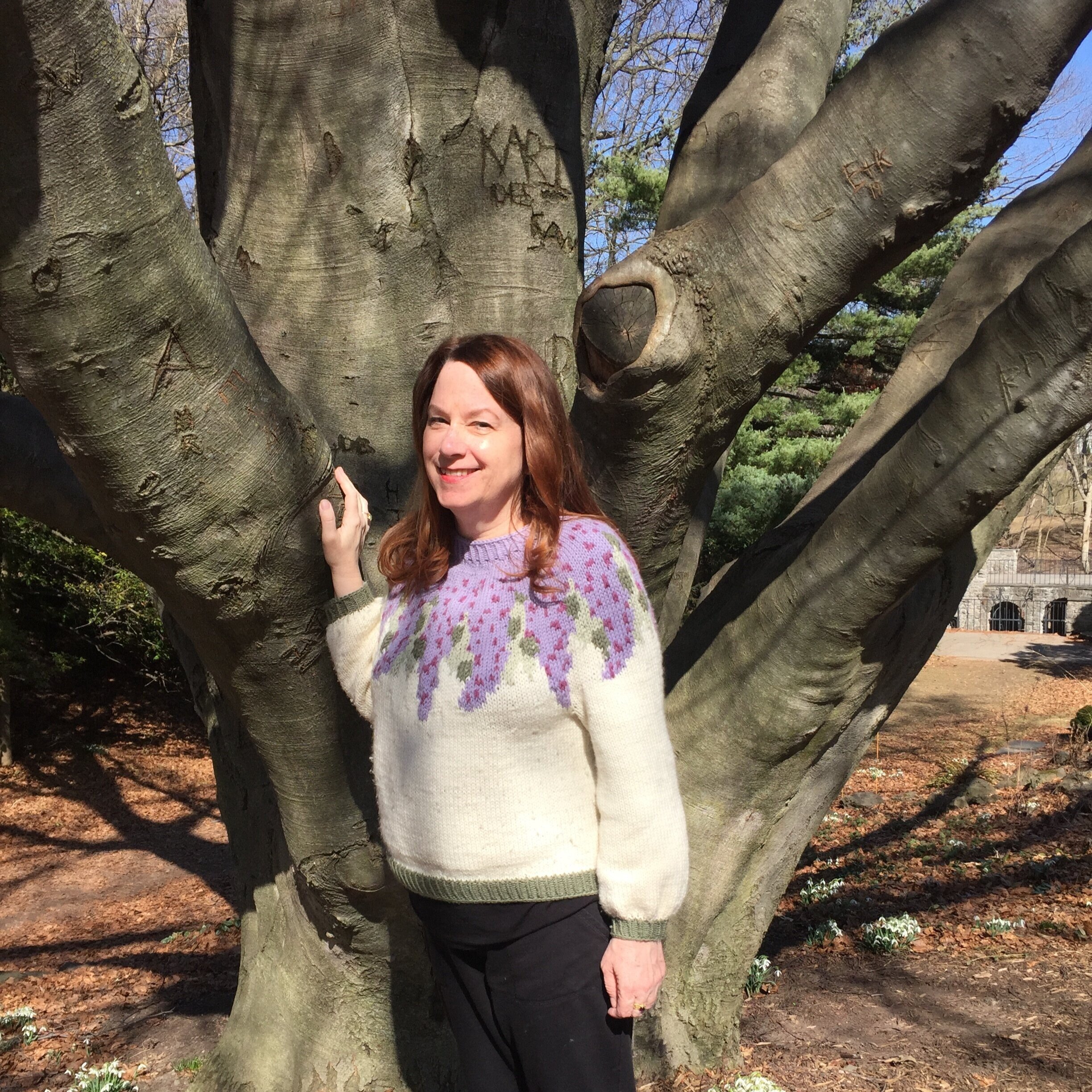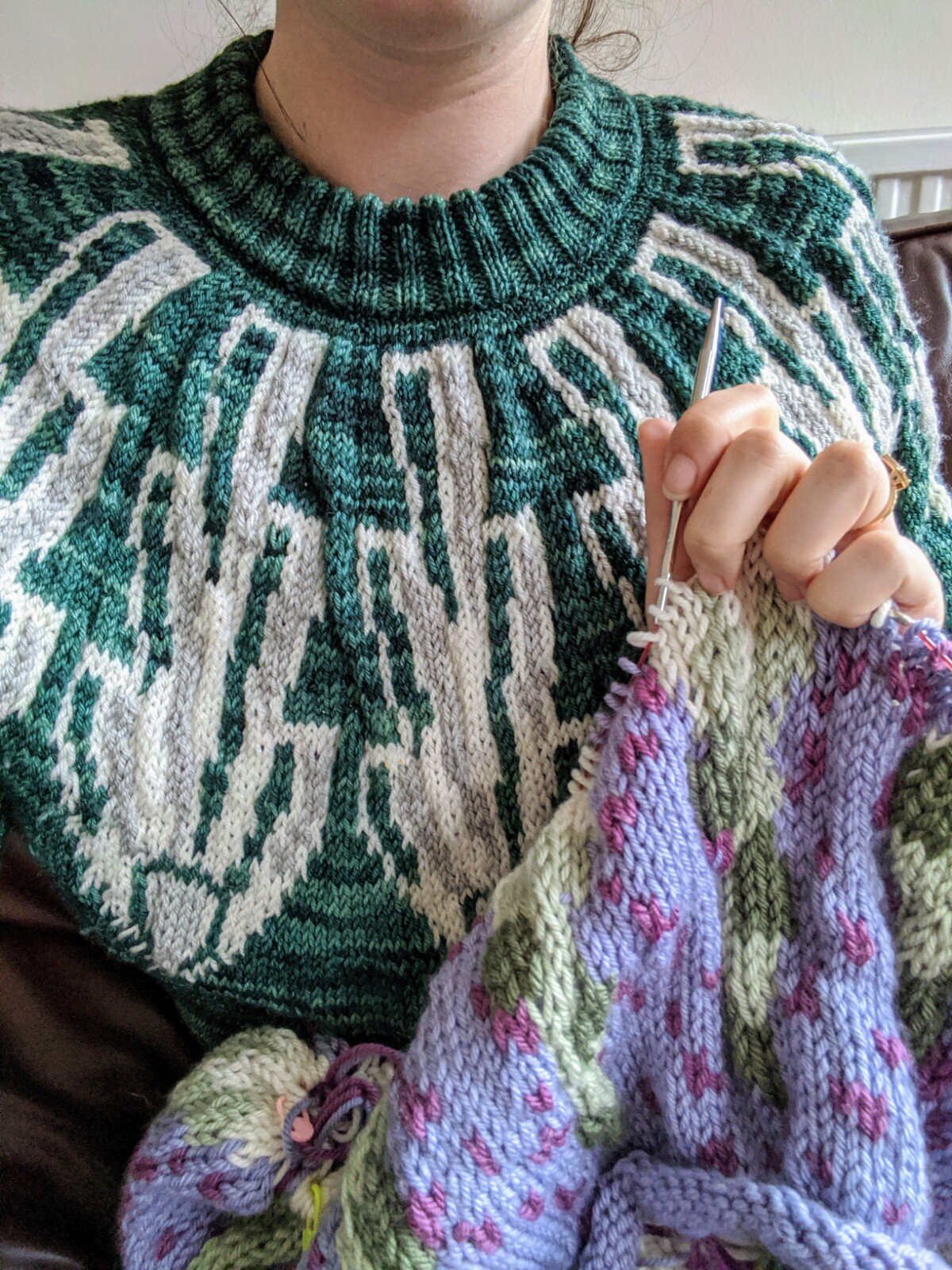The Lilac Pullover: Tree Collection
This is the blog post and inspiration for the third pattern of the year long Tree Collection by The Queen Stitch and LoveCrafts. Read More about the Tree Collection here.
Mom (Molly) [Mall-EE]
My mom and I met August 9th, 1991 when I was born 14 days late, in a raging heatwave, just outside of Washington D.C. My mom is petite, shy, well-read, and once trained to be a ballerina. She is introverted but with very progressive views on education and particularly on public and women's health - which, growing up in the suburbs, I found shocking, and incredibly embarrassing. I, unlike my mother, had enough energy to power a small province, was into contact (or whatever kind) of sports, and never had enough time to brush my hair or bathe properly. I took after my dad in terms of stature and was trying desperately to fit in - being so much bigger than the other girls (and my mom) so early on.
It was very hard for me to empathize with someone so different to me, and we fought a lot. However, in our adult lives a lot of similarities have arisen - like our inability to say no to a good party, lewd sense of humor, aversion to washing dishes, and strong support for sexuality and health education. My mom was there for me during the most painful moments of my life with empathy and patience, when I probably didn’t deserve it. Her enduring strength and ability not to react to bullshit is something I hope to achieve at some point. At least now I recognize how lucky I was that she held the views she did and does.
Mom with her brothers and dad in the woods
Me and mom in Kew Gardens
My mom serving up some pudding with a side of style
Rochester, NY
Growing up in Rochester (and Fairport - a suburb) in her own words...
“Fairport was the quintessential small town. It was close to [another small town] where my dad worked, so that’s why we lived there. In school I was in all the honors classes with 30 other kids and we were in all each other's classes from 7th grade til we graduated. We all knew each other which was good and bad, I remember there were more girls than boys. I liked school because I did well, and I had some excellent teachers who I connected with and helped motivate me.
“Even though I liked school I was bullied a lot. I was a year younger than everyone else because I’d been moved up, and being already pretty small, I was picked on. I felt very isolated and was sensitive and shy, so I didn’t have many friends. Only ever about 1 or 2 at a time.
“I had a full life though. My mom and dad let me take piano and ballet lessons as well as my schooling. But even then I was depressed, though I hadn’t been diagnosed yet [my mom was diagnosed with Bipolar later in life]. It’s annoying looking back at all the red flags that we didn’t notice, both me and my parents recognize now…
“My mom was very good at organizing us into outings. We had a cabin in the southern tier [of New York State] - freezing, boring, with dead mice in the bathtub. My dad dragged us there to hunt in the woods... But fun ones too, like Lilac park [Highland Park] and Seabreeze [a local amusement and waterpark].
“Regardless, it felt insular growing up there, and seemed like no one ever had adventures or travelled anywhere. When I got into Smith, and the various other colleges, I thought I would never go back. I was really motivated to get out - getting good grades would let me get the hell out of dodge. I thought Fairport was a provincial backwater!
“But I did go back, to my utter amazement. After I gained my confidence, and got out of my shell in college and law school. I still get nervous meeting new people, but now I can put on, what I call, my ‘extrovert costume’. I lived in Albany, Boston, Washington DC, Baltimore, New York City first, but I went back because of you. It is, in fact, a really great place to raise kids. Relatively safe, really in-expensive, with a lot of really great public schools in the suburbs and lots of enrichment opportunities like summer camps and things… plus family [my great grandparents, grandparents, and many cousins still live in Rochester] !
Working on the lilac yoke with a spring bouquet
The original sketch of this sweater featured the Rochester logo
The lilac yoke
Why the Lilac
Like many things now common in the US, the Lilac is not native to the States. Around the 15-1600s Lilacs had been brought to Europe from the Balkans, and then by the 1800’s they were subsequently transported to the Americas. While it’s a relatively recent addition to the landscape, the plants grew well and flourished.
Among the very first American transplants was in Highland Park in Rochester, NY. A beautiful park designed by Frederick Law Olmstead of Central Park fame. The Lilac collection was started in the late 1800s with 20 varieties of lilacs, some of which were direct descendants of the native Balkan species. The park now has over 1800 bushes, and 500 different varieties. Rochester hosts the Lilac Festival every year (we’re on year 123!), with up to 500,000 people attending.
Lilacs are quite important to Rochester, which has earned its nickname, “The Flower City”, and even the logo for the city is meant to represent a lilac blossom.
My mom purchased a house right near Highland Park when I was about 7 or 8, and we spent a fair amount of time enjoying and exploring in the park growing up. My mom is a big fan of lilacs and had multiple lilac perfumes and potpourris, so the smell always reminds me of her now.
My mom says, “To me they represent home. I guess I haven’t represented that I like home particularly much… but it reminded me of the good things about home....They smell fabulous, and they come in so many different colors. They bloom over 2 months but are completely maintenance free once you get them started… it takes about 3 years to bloom the first time. I’ve always planted lilacs wherever I’ve lived, with the exception of DC, it was too hot there. Lilacs are ubiquitous around here and considered not very fancy - and that’s ironic to me since they’re so beautiful.”
References:
Rochester Lilac Festival". Rochester Events. Archived from the original on May 1, 2013. Retrieved April 4, 2015.
Fien, Christine Carrie “Rochester Pride on Your Hide” 18 Dec 2013 Rochester City Newspaper Retrieved 1 Aug 2020 https://www.rochestercitynewspaper.com/rochester/rochester-pride-on-your-hide/
This is actually a buddleia or “Butterfly Bush” but they are much more common to the UK and always remind me of lilacs and my mom
Working on the sweater while wearing the Park Lane sweater
My mom in her lilac pullover <3
Facts + Folklore about Lilacs
Lilac is a small tree or a large deciduous shrub, I’m taking the liberty of calling it a tree as it can grow up to around 25 feet. It has gray, or gray-brown bark, shiny green oval leaves, and dainty tubular flowers culminating in a four lobed top. The flowers can be anything from light purple, to mauve, to white, to pink and all smell delicious. They are edible too, but don’t taste as good as they smell with an astringent and bitter taste - best as a garnish.
Lilacs have some antiseptic properties and were used in traditional medicine to treat worms, headaches, and fever, and as an anti-malarial. The astringent properties in lilacs make it a good facial tonic for acne, and reducing inflammation, and redness.
The oil from these flowers is said to ease anxiety and release tension, and in the Pagan and Wiccan traditions, are used for banishing negative or heavy ‘winter’ energies. Making way for productive ‘breakthrough energies’. Representing a short, light romance, they are used in spell work for playful flirtations. In the Victorian language of flowers, too, the lilac represents new love.
However in Britain it’s seen as unlucky to bring lilacs (and other spring flowers) into the house. This may be because historically lilacs have been used at funerals to mask the scent of death, as the scent is light but strong. The Hebrew name for lilacs is ‘pasha’ meaning passage, perhaps for the same end-of-life implications, and they were thought to drive ghosts away. In the colonial US, Lilacs were used to mark the graves of stillborn or miscarried babies.
On the other side of the coin, Orthodox Christians equate the flower with resurrection and use the flower in Easter rituals. As it’s one of the first spring flowers they have long been associated with the passage of time and rebirth.
References:
Foley, Michaela The Alchemist's Kitchen “Lilacs: The Fragrant Vernal Flower” https://wisdom.thealchemistskitchen.com/lilac-the-fragrant-vernal-flower/ (2020) visited 9/11/20
Wigington, Patti Learn Religions “Paganism and Wicca: Lilac Magic & Folklore” https://www.learnreligions.com/lilac-magic-and-folklore-4064885 (2019) visited 9/10/20
Vickery, Roy Plant-Lore “Lilac” https://www.plant-lore.com/lilac/ (2010) visited 9/10/20
Click Here for The Pattern
My mom is big fan of cozy. She’s always cold and likes to be wrapped up in millions of sweaters, shawls, and pashminas. So this design was always going to be something toasty. This spring sweater is meant for Rochester springs, where it snows until May.
This is a top-down, yoke style sweater. Meaning it’s worked as one seamless piece from the neck, split at the bust, lengthened with short rows at the upper back, and then worked down for extra length. I used Debbie Bliss Cashmerino Aran for a soft, washable, and cozy design that works up quickly!












